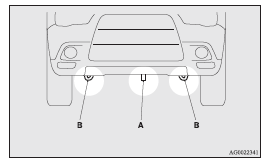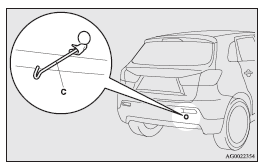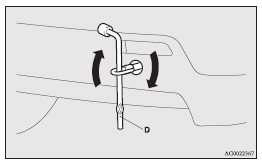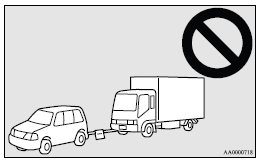Emergency towing
If towing service is not available in an emergency, your vehicle may be temporarily towed by a rope secured to the towing hook.
If your vehicle is to be towed by another vehicle or if your vehicle tows another vehicle, pay careful attention to the following points:
If your vehicle is to be towed by another vehicle
1. The front towing hook (A) is located as shown in the illustration. Secure the tow rope to the front towing hook.

![]() NOTE
NOTE
• Do not use the tie-down hooks (B) for towing.
These hooks are provided only for the purpose of transporting the vehicle itself.
Using any part other than the designated towing hook (A) could result in damage to vehicle body.
• Using a wire rope or metal chain can result in damage to the vehicle body. It is best to use a non-metallic rope. If you use a wire rope or metal chain, wrap it with cloth at any point where it touches the vehicle body.
• Take care that the tow rope is kept as horizontal as possible. An angled tow rope can damage the vehicle body.
2. Keep the engine running.
If the engine is not running, perform the following operation to unlock the steering wheel.
[Except for vehicles with keyless operation system] Turn the ignition switch to the “ACC” or “ON” position (M/T) or “ON” position (CVT).
[For vehicles with the keyless operation system] Put the operation mode in ACC or ON (M/T) or ON (CVT).
![]() NOTE
NOTE
• For vehicles equipped with the Auto Stop &
Go (AS&G) system, press the “Auto Stop &
Go (AS&G) OFF” switch to deactivate the Auto Stop & Go (AS&G) system before stopping the vehicle.
Refer to “To deactivate”.
![]() WARNING
WARNING
• When the engine is not running, the brake booster and power steering system do not operate. This means higher brake depression force and higher steering effort are required. Therefore, vehicle operation is more difficult than usual.
![]() CAUTION
CAUTION
• Do not leave the ignition switch in the “LOCK” position or the operation mode in OFF. The steering wheel will lock, causing loss of control.
3. Place the gearshift lever in the “N” (Neutral) position (M/T) or the selector lever in the “N” (NEUTRAL) position (CVT).
4. Turn on the hazard warning lamps if required by law.
(Follow the local driving laws and regulations.)
![]() CAUTION
CAUTION
• The person in the vehicle being towed must pay attention to the brake lamps of the towing vehicle and make sure the rope never becomes slack.
• Avoid sudden braking, sudden acceleration and sharp turning; such operation could cause damage to the towing hooks or the tow rope.
People in the vicinity could be injured as a result.
• When towing or being towed down a long slope, the brakes may overheat reducing the effectiveness. In this situation, have your vehicle transported by a tow truck.
• When the vehicle equipped with CVT is to be towed by another vehicle with the all wheels on the ground, make sure that the towing speed and distance given below are never exceeded, causing damage to the transmission.
Towing speed: 40 km/h (25 mph)
Towing distance: 40 km (25 miles)
For the towing speed and the towing distance, follow the local driving laws and regulations.
If your vehicle tows another vehicle
1. Take out the towing hook, wheel nut wrench and jack bar.
Refer to “Tools, jack and tyre repair kit”.
2. Cover the end of the jack bar (C) with cloth and use it to remove the lid from the rear bumper.

3. Use the wheel nut wrench (D) to firmly attach the towing hook.

4. Always attach the tow rope to the towing hook. Otherwise, the instructions are the same as for “When being towed by another vehicle”.
5. When finished towing, remove the towing hook, and stow it in the specified location.
Refer to “Tools, jack and tyre repair kit”.
When installing the bumper lid, align the hook with the cut out area on the vehicle, and firmly insert.
![]() NOTE
NOTE
• Do not tow a vehicle heavier than your own vehicle.

See also:
Dead Lock System
The Dead Lock System helps to prevent theft.
When the keyless entry system or the keyless operation system has been used to
lock all of the doors and the tailgate, the Dead Lock System makes it imp ...
Removal of head restraints
To remove the head restraints, lift the head restraint with the height adjusting
knob (A) pushed in.
To install the head restraints, first confirm that they are facing in the correct
direction, ...
Driving range display
This displays the approximate driving range (how many more kilometres or miles
you can drive).
When the driving range falls below approximately 50 km (30 miles), “---” is displayed.
Refuel as ...
